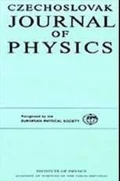Abstract
The electronic Raman effect in superconductors can be caused by photon induced pair breaking and by the presence of thermally excited quasiparticles. We show that these contributions can be separated and that information about the symmetry of the energy gap can be obtained from each contribution separately.
Similar content being viewed by others
References
D. Einzel and R. Hackl, J. Raman Spec.27, no3/4 (1996); D. Einzel and C. Schuster, to be published
M. V. Klein and S. B. Dierker, Phys. Rev. B29, 4976 (1984).
T. P. Devereaux et al, Phys. Rev. Lett.72, 396 (1994)
T. Staufer et al, Phys. Rev. Lett.68, 1069 (1992)
Author information
Authors and Affiliations
Rights and permissions
About this article
Cite this article
Einzel, D., Schuster, C. Two-fluid description of Raman-scattering in anisotropic superconductors. Czech J Phys 46 (Suppl 2), 993–994 (1996). https://doi.org/10.1007/BF02583804
Issue Date:
DOI: https://doi.org/10.1007/BF02583804




